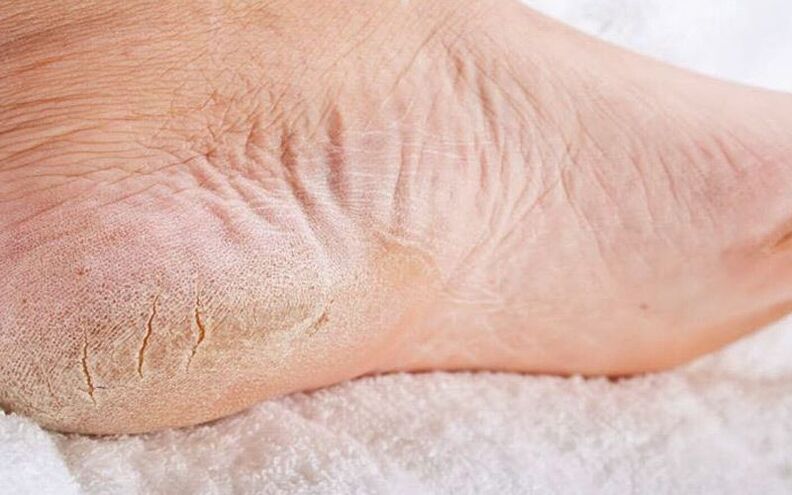
Fungal infections often affect the toes or nails. This disease affects both adults and children. To prevent the pathology from becoming chronic, you need to know the signs of foot fungus and what the disease looks like.
The main symptoms of the disease
Among all skin diseases, foot mycosis is the most common. You can contract this disease by ignoring basic hygiene rules. Sometimes it is very difficult to cure fungus.
For each person, athlete's foot starts and develops in its own way. Here are the most common signs by which foot fungus can be recognized:
- characteristic cracks appear between the toes;
- You can tell that the fungus has appeared by the characteristic itching on your feet and between your toes;
- the skin of the feet is very dry, it often peels and becomes rough;
- blisters appear between the fingers, which burst when destroyed;
- infection can spread to neighboring areas;
- red spots appear on the skin, which cause significant discomfort;
- You can also recognize toenail fungus by its unpleasant odor.
When the first symptoms of the disease appear, you should immediately see a dermatologist. If you don't do this first, it will be more difficult to treat the fungus.
Fungal symptoms depend on the type of pathogen
This disease develops due to various types of pathogens. The symptoms of foot damage will be different in each case.
- If the yeast fungus develops on the feet, the nail gradually thins and peels off from the bed. The skin on the legs is hyperemic (takes on a red hue).
- With the development of epidermophytes, the nails turn yellow and become covered with spots. The skin on the feet peels and emits an unpleasant odor. A characteristic symptom of this type of fungus is increased dryness of the skin.
- When mold fungus appears, the nail plate can suddenly change color. The skin becomes red if the pathogen gradually spreads to the entire leg. A person is bothered by itching, and the skin may crack. In this case, pain and other unpleasant sensations appear when walking.
Only a doctor can determine the type of pathogen. This cannot be done at home. And if you practice self-medication, you can only harm yourself. Your feet will experience this, and the skin fungus will spread further.
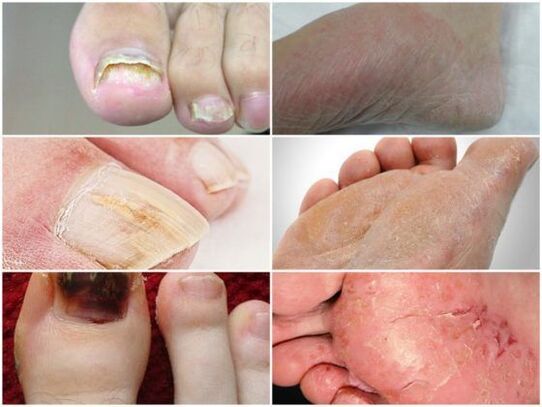
Signs of some forms of fungus
Depending on the affected area and the level of development, several forms of pathology are distinguished. Each symptom is different. Knowing the early signs of foot disease, you can start treatment for mycosis in time.
- Interdigital dermatophytosis is the most common stage of the disease. It becomes more active in spring and summer, when the feet sweat the most. Cracks and sores appear between the fingers. You can see the presence of scales on their skin. Legs look completely healthy. Often a person feels itchy.
- The deleted form appears at the most obscure level. Flaking is noticeable between the fingers. At this stage of the disease, an unpleasant sharp smell spreads from the feet: it appears due to increased bacterial activity.
This disease can occur in many forms. Let's get acquainted with their signs so that we know how to identify the fungus on the feet and, if it develops, start treatment. It should be remembered that in the advanced stages of the nail disease it is completely destroyed. It is almost impossible to recover it.
Squamous type
This fungus is characterized by intense peeling of the epidermis. Moreover, the skin area between the toes and the side of the foot is most intensively affected. There are no signs of inflammation. In the photo of the first signs of foot fungus, hyperemic areas are noticeable. Squamous fungus looks like this:
- thickened stratum corneum;
- the skin shines, sometimes becomes thick;
- patterns on the skin become clearer;
- the fungus gradually spreads to the fingers, the whole leg, and affects the nails;
- sometimes lamellar scales appear on the epidermis;
- The patient does not feel any other unpleasant sensations.
Dyshidrotic type
With this fungus, small blisters filled with liquid appear on the skin. They are usually found on the side of the leg. Then they gradually move to the inside of the fingers. How to recognize dyshidrotic foot fungus:
- bubbles are usually single, but if there are many of them, they merge into one big one;
- if left untreated, the fluid in the blister gradually darkens;
- If the blister bursts, erosion with a crust appears in its place.
With this type of foot fungus, there is a very high risk of bacterial infection. Infection enters the body through open skin lesions.
Intertriginous type
This type of fungus is the most common. At first, the person does not feel any symptoms. Up to a certain point, the skin on the toes does not change. After that, cracks and layers appear. The skin is not affected, but it may sweat.
Foot candidiasis
The characteristic symptoms of this fungal infection are as follows:
- lesion is the 3rd or 4th toe;
- red and swollen skin;
- There is a bubble around the lesion where there is a layer of peeled skin;
- There are pustules and blisters nearby.
If a bacterial infection enters the affected area, it leads to an increase in local temperature. Significant swelling on the skin of the feet. In severe cases, a person experiences generalized hyperthermia.
Signs of a fungal nail infection
A person's toenails may also be affected. This disease can be distinguished by the following symptoms.
- Significant changes in the color of the nail plate. Depending on the type of pathology that the patient has, the nails take on different colors. Sometimes it can change only on the part of the nail plate.
- Nails fall off. It only happens at an advanced stage. If the nail is completely infected, it is destroyed.
- Changes in nail structure.
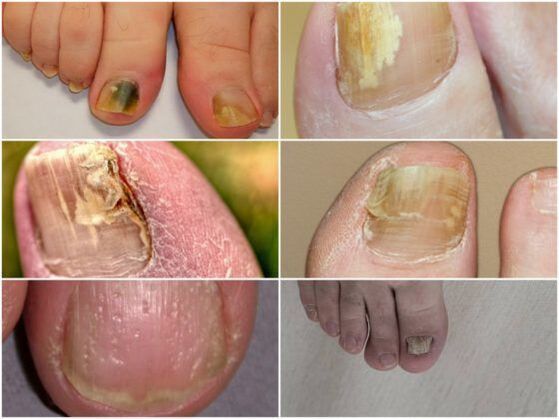
There are several types of onychomycosis, a fungal infection of the nails.
- Atrophic appearance. The nail plate looks very thin. It darkens, sometimes acquires a gray-brown color. The nail gradually peeled away from its bed. The skin underneath becomes keratinized and becomes loose.
- With the normotrophic form of foot fungus, the plate changes its shade. Spots appear on it - white, yellow, green and even black. The nail structure is not affected.
- In the hypertrophic form, the plate gradually thickens and becomes porous. The affected area looks very unsightly and in some cases causes pain when walking. On the side it collapses and collapses without treatment.
Some types of onychomycosis
Depending on the degree of spread of the disease, its form is distinguished.
- Lateral onychomycosis is the most common. Small yellow spots first appear on the free edge of the nail. In the future, you will see how it increases, and the nail plate thickens. While walking, a person feels uncomfortable. The spread of unpleasant odors is noticeable. Lateral onychomycosis is difficult to treat.
- Superficial onychomycosis is characterized by damage only to the upper layer of the plate. It does not thicken, but over time it becomes chalky.
- The rarest form of this disease is subungual onychomycosis. The skin thickens significantly in the nail folds. Nails become white and lose their transparency.
General principles of treatment
Any pathology treatment begins with a diagnosis. Only then can the appropriate medication be prescribed. Self-medication usually leads to deterioration of the condition of the legs. Let's get acquainted with the most common methods of therapy.
- At the first signs of fungal infection, special varnishes, plasters, ointments, and sprays are used. They must be used for a long time and according to the instructions.
- If local therapy is ineffective, complex antifungal drugs are prescribed. They are used orally.
- Surgical removal of the affected nail.
- Laser therapy.
- In advanced forms of the disease, systemic drugs are prescribed.
You can avoid the occurrence of unpleasant diseases by following hygiene rules. You should avoid using other people's personal hygiene products (towels, slippers). When the first signs of the disease appear, you should immediately see a doctor.
Types of mycosis
Fungal infections of the feet usually appear between the toes. It is caused by several types of fungi. This problem most often exists in adults, because children's sweat can disarm the fungus.
Mycotic lesions can be of different types:
- candidiasis - occurs when the body's resistance decreases, most often in women;
- epidermophytosis is an exclusively "male" disease that develops due to excessive sweating;
- Rubromycosis is a highly contagious form that can occur even in young children.
Signs and symptoms of the disease
The signs of a fungal infection may vary depending on the age of the patient, the state of the immune system and the nature of the blood circulation.
In a person with a strong immune system, the fungus can remain on the skin for several months without showing itself. Slight itching and slight redness of the skin may occur.
The best treatment and cure
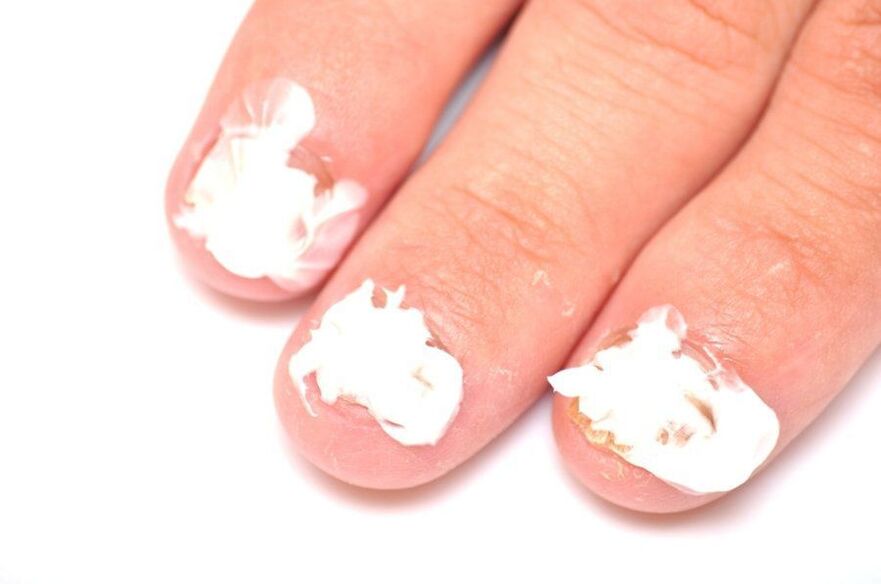
Advanced mycosis is treated with fungicide tablets and antimycotic ointment. The latter is used after washing and drying the feet.
Folk remedies are recommended to be used only in the early stages of the disease, as well as to relieve itching. They must be used very carefully as some rely on skin cauterization and can cause burns.
As for traditional medicine, it is used at the patient's own risk. Special care should be taken when using formulations containing vinegar, celandine or manganese, as these can cause skin burns.
In parallel with drug treatment, you can use a bath with oak bark, chamomile or sage. Baking soda effectively reduces itching.
Preventive measures
Although there are effective and inexpensive treatments for athlete's foot on the market, it's best not to let the problem develop. Prevention of fungal infections consists of:
- in daily hygiene;
- wearing individual shoes (especially in public baths, showers and swimming pools);
- regularly treat the inside of shoes with ammonia;
- change socks daily;
- strengthen and maintain immunity.
This is a basic and simple step that anyone can do. But if the infection occurs, then to prevent relapse, it is necessary to treat foot fungus with medicines for another 14 days after the complete disappearance of all symptoms of mycosis.
Toenail fungus: symptoms and treatment, photo of toenail fungus
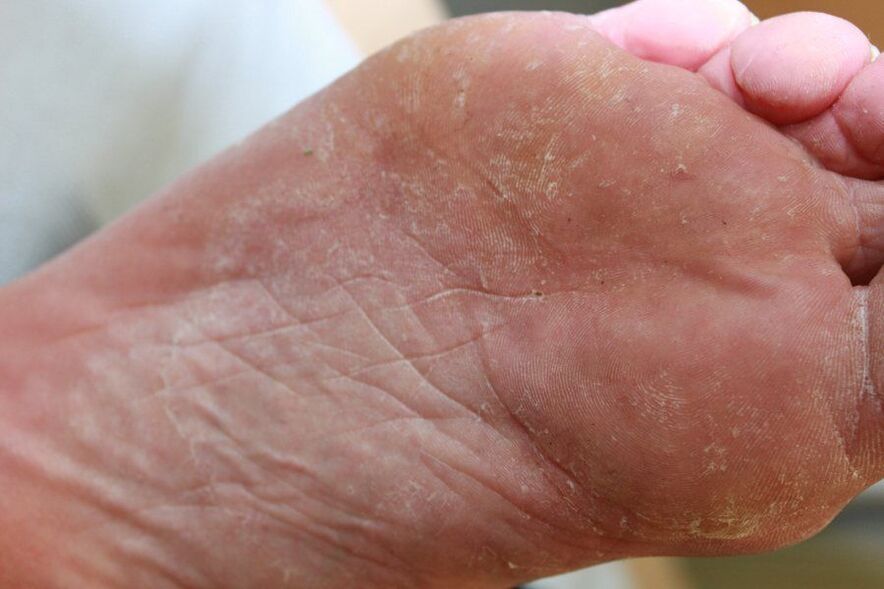
Athlete's foot is one of the most common diseases in dermatology practice. It occurs mainly in cultures where it is customary to wear shoes most of the time, and affects up to 70% of the adult population.
Most often, foot fungus is observed in the elderly, as well as those whose immunity is significantly weakened, for example, with diabetes, AIDS, circulatory disorders in the lower part of the feet and other diseases of this type.
Often, the term "foot fungus or mycosis" refers to damage by fungal mycelium on the plantar skin of the foot, nails and interdigital spaces.
Pathogens
Among the various types of fungi, the main causative agents of foot mycosis are the following:
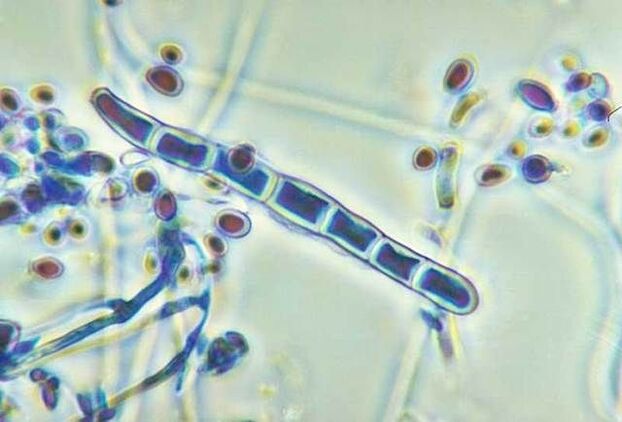
- Trichophyton rubrum,
- Trichophyton mentagrophytes,
- Epidermophyton floccosum.
Other causative agents of fungal infections of the feet, which are not so common:
- Trichophyton tonsurans is the causative agent of mycosis in children in America,
- candida,
- Scythalidium hyalinum,
- Scythalidium dimidiatum.
All pathogens of fungal infections have adapted to become parasites in the stratum corneum of the skin, producing special enzymes that break down keratin. In addition, their membranes (cell walls) contain mannans - special substances that suppress local immunity and contribute to the development of chronic inflammation.
Routes of infection and factors contributing to disease
It is believed that some types of fungal foot pathogens are able to maintain their viability in the exfoliated pieces of skin for a year. To become infected with the fungus, it is enough for such a fragment of skin with the pathogen to stick to the leg, and then fall into conditions suitable for reproduction: moisture and heat.
The most common fungal infections of the feet occur:
- In public places: baths, beach beds, swimming pools, saunas, even just beach sand.
- In the family: shared house shoes, lack of individual towels for the feet, low level of cleanliness.
- Habits: changing shoes, socks, wearing other people's shoes (for example, host's house slippers when visiting).
Factors contributing to infection:
- Decreased local protection due to blood circulation disorders (for example, with vasculitis, atherosclerosis that obliterates the lower leg), certain chronic diseases (HIV, other immunodeficiency conditions, diabetes mellitus, etc. ).
- Prolonged sweating of the feet in athletes during long training, in summer when wearing closed shoes or poor ventilation.
- Cracks and maceration on the skin of the feet.
In general, men get sick more often than women; with age, the frequency of fungal infections on the feet increases. Risk groups for fungal infections of the feet are:
- miner,
- military personnel,
- bath attendant,
- regular bath and sauna,
- athlete.
Types of diseases
According to the location of the focus of skin pathology on the feet affected by fungus:
- Interdigital mycosis (dermatophytosis). It is most often observed in the form of chronic (squamous) or acute (intertriginous) forms.
- Plantar mycosis. Often it manifests itself as peeling and keratinization of the skin of the feet.
- Dyshidrotic dermatophytosis. Blisters and vesicles form on the skin of the feet, often reminiscent of allergic dermatitis.
- Deep mycosis. In this case, not only the superficial surface but also the deep layers of the skin are affected.
- Onychomycosis. Toenail fungus infection.
Depending on the type of pathogen, the main fungal diseases of the feet are:
- Athlete's disease caused by Trichophyton mcntagrophytes.
- Rubrophytosis, caused by Trichophyton rubrum.
Rubrophytosis of the feet: types and main symptoms
Rubrophytosis is the most common fungal disease of the feet. Happens in almost 70-90% of cases.
symptoms
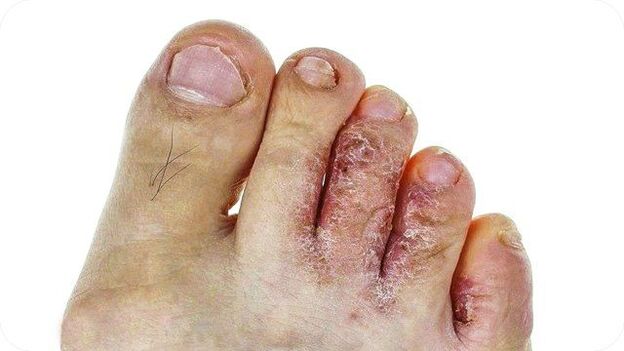
The classic form of rubrophytosis is characterized by redness and moderate thickening (lichenification) of the skin. The affected skin is shiny, with an enhanced pattern, the surface is dry with floury scales accumulating in the areas of furrows and folds.
Usually the disease begins with the third or fourth interdigital fold, which is the tightest. The fungus then spreads to other spaces between the toes, the plantar part and the back of the foot.
The following forms are characteristic of rubrophytia:
Commonly encountered:
- squamous form (the main symptom is peeling skin),
- form of keratinization - the presence of "corns", thickening.
- intertriginous (opreloid),
- dyshidrotic (with the formation of blisters),
- mixed form (diaper rash, blisters).
On the feet
Suppressed squamous rubrophytia has the least noticeable symptoms and persists almost unnoticed by the patient. Its main symptoms:
- Interdigital space: peeling, the presence of flour-like scales, shallow small cracks.
- Almost no complaints or minor itching can bother you.
In this form, rubrophytosis can last for quite a long time. However, the gradual development of the disease is observed, which leads to the appearance of hyperkeratotic and mixed forms. Gradually there are:
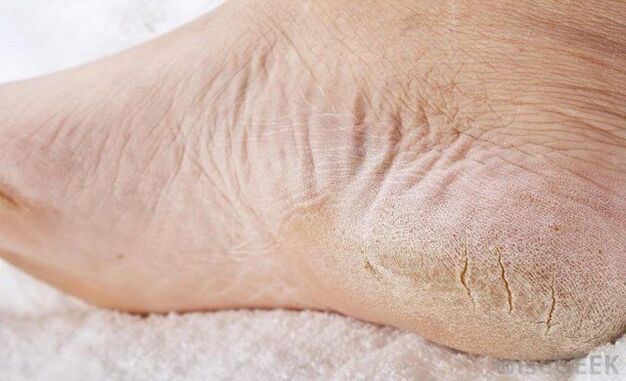
- increased dryness of the skin of the feet,
- skin roughness,
- the appearance of rough calluses on the soles and sides,
- the formation of deep and painful cracks in the heel area.
With foot rubrophytosis, 3 main types of skin peeling are observed:
starched The skin's natural folds and creases look powdered.Ring shaped . Red spots with exfoliated epithelial edges.Large lamellar . In this case, the skin peels off in a large plate.
In the interdigital space
During strong sweating of the feet, wearing shoes with poor ventilation, or insufficient treatment, the space between the toes periodically starts to get wet. The skin becomes swollen, eroded, with deep cracks. The main complaints of patients at this stage are itching, pain, burning.
Without timely and effective treatment, the process gradually worsens, which is indicated by increased pain and itching, which increases with movement. Large blisters appear on the skin of the interdigital space and the lateral surface of the fingers, which later turn into erosions, surrounded by a whitish epidermal border.
On the nails
Toe nail plate with rubrophytosis:
- thicken,
- collapsed,
- yellowish gray or with a brown color,
- chiseled white spots that later spread to the rest of the nail.
Sometimes they separate from the nail bed, thicken and take the appearance of a bird's claw or an ingrown nail, which causes additional discomfort for the patient.
Complications of rubrophytosis
As a rule, rubrophytia spreads to other parts of the body: hands, smooth skin, vellus hair. Pathogens enter new areas of the skin with lymphogens, as well as contact (for example, transferred by hands when washing feet).
- Hands - damage to the palms and nails.
- Smooth skin - wounds on the face, inguinal-femoral folds, buttocks, legs.
In this case, mycosis manifests itself as pink-red or round pink spots with a tendency to merge and develop peripherally. Their surface is covered with scales, and along the edges there are inflammatory ridges with small bubbles and crusts.
If rubrophytia has spread to large folds, itching occurs.
Athlete's foot: types and symptoms
Athlete's foot occurs less often than rubrophytosis and has the same form of the disease:
- Deleted.
- keratinization.
- Diaper rash.
- With foam formation.
- Athlete's nails.
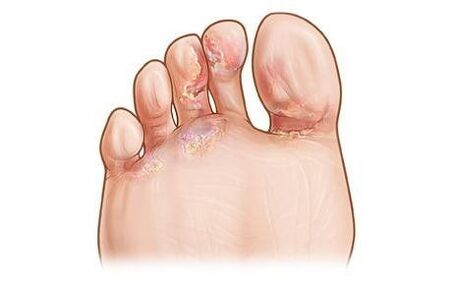
Next, a plaque-like thickening of bluish-red skin appears on the lateral surfaces and soles of the feet. In the center of the rash there is a layer of scale, the border of the lesion is clear. In the space between the fingers, the epidermis acquires a whitish color.
With athlete's foot, patients are bothered by itching, increased dryness and pain in the skin.
The opreloid (intertriginous) form of epidermophytosis is characterized by redness, swelling and squeezing of the interdigital folds. Cracks often form and pain is felt.
When the pathogen affects the arch of the foot, the dyshidrotic form can often be observed with the formation of blisters, which, after opening, look like pink or red wet erosion.
Athlete's foot most commonly occurs on the big toe (I) and big toe (V). In the thickness of the nail, closer to the free edge, yellowish spots and stripes are formed, which gradually increase and occupy the entire nail. Next, the nail begins to crumble, sometimes peeling off the nail bed.
Acute epidermophytosis Podvysotskaya
The main symptoms of this athlete's foot shape:
- swollen feet, fingers,
- many vesicles,
- crying erosion,
- interdigital fold squeezing,
- enlarged inguinal lymph nodes
- increased body temperature,
- Headache,
- difficulty walking due to pain,
- general weakness.
Onychomycosis of the toes: symptoms and types
In addition to the causative agents of rubrophytosis and epidermophytosis, onychomycosis can be caused by yeast fungi of the genus Candida, as well as several other fungi.
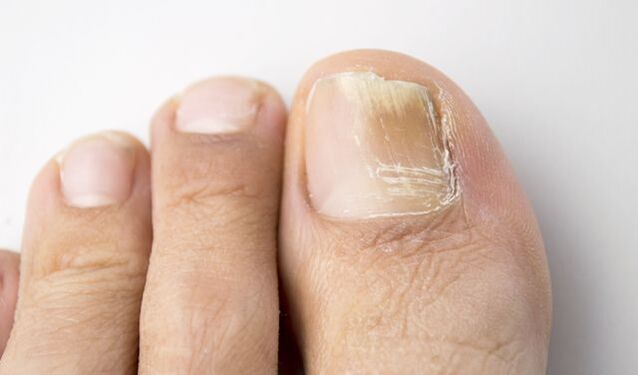
The most typical symptoms of onychomycosis, which begins closer to the free edge of the nail:
- discoloration, loss of natural luster,
- thickening of the nail plate,
- occurrence of subungual hyperkeratosis,
- nail destruction, detachment from the nail bed.
With onychomycosis, there are 2 main types of nail damage:
- Normotropic: white and yellowish stripes appear on the thickness of the nail.
- Atrophic: thinning, destruction of the nail plate, its detachment.
Diagnosis of fungal infections of the feet
Specialists in the treatment of fungal infections of the feet are dermatologists who, if necessary, can involve other specialists in the treatment.
After a conversation with the patient, an explanation of the complaint and the characteristics of the occurrence and course of the disease, the doctor will examine the affected surface and prescribe several types of additional examinations, for example:
- Microscopic examination with additional treatment of the material with potassium hydroxide.
- Wood lamp inspection.
- Inoculation of suspicious biological material on special media for fungal growth, as well as on media for bacteria.
Treatment
Treatment for any fungal infection on the feet must be prescribed by a doctor to achieve complete healing.
In general, the treatment of foot mycoses is based on the following therapeutic principles:
- Fight infectious agents. In the early stages of the disease, local drugs are usually prescribed - antifungal ointments, creams, lotions. In severe cases, use systemic antifungal agents.
- Improves immunity and improves local blood circulation, treating underlying diseases.
- Desensitization therapy. Since foot mycosis is often accompanied by an allergic reaction, antiallergic drugs are prescribed accordingly, which will help improve the patient's condition.
Treatment at home
- To effectively treat mycosis of the feet, remember that the fungus thrives in a moist environment. By excluding moisture, the fungus will not grow, and the chances of healing will increase.
- Protect your family members from fungal diseases. You should explain to them that from now on you cannot walk barefoot in the apartment, especially in the bathroom or shower. After a bath or shower, it is necessary to treat the bath itself, the tray and the floor with a disinfectant.
- Wash your feet every day with soap, collect all the pieces of skin that fall with a napkin so that nothing gets under the nails.
- After washing your feet, be sure to dry the space between your toes with toilet paper or a hair dryer, and then use an antifungal agent prescribed by your doctor. Treatment must be continued for several months even in cases where the manifestations of mycosis completely disappear.
- Use powder when wearing shoes.
- Wear white cotton socks (clean daily). Socks that have been used should be boiled or soaked in disinfectant for 10 minutes. Shoes must be disinfected using an antifungal spray.
Prevention of foot mycosis
Timely treatment of diseases that can reduce the body's defenses or affect blood circulation.
Conclusion
Athlete's foot is one of the most common fungal skin infections. In most cases, following simple preventive rules helps to avoid the disease, and timely treatment begins to completely eliminate mycosis.

























